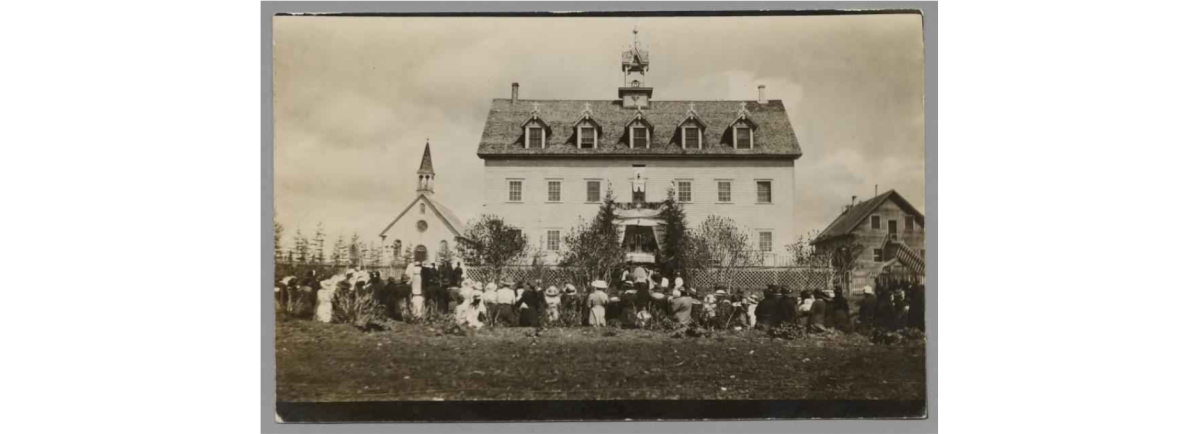Editor’s note: This story initially said unmarked graves were found, but has been updated to say anomalies consistent with unmarked graves were found. Global News regrets the error.

Anomalies consistent with unmarked graves have been found at the site of a former residential school near High Prairie in northern Alberta, the local First Nation said.
Kapawe’no First Nation made the announcement on Tuesday. During Phase 1 of the search, 169 anomalies were found at the Grouard Indian Residential School, also known as St. Bernard Mission School.
Of those, 115 were found in the community cemetery with no grave markers, while the other 54 were found outside of the cemetery.
The first phase of the search covered only one acre of the vast property.
“Finding one grave is too much. Finding multiple is incomprehensible,” Kapawe’no First Nation Chief Sydney Lee Halcrow said in a news conference. “My thoughts (and) prayers go out to the families whose loved ones never made it home and who died at these so-called schools.”
Halcrow said the team can be “reasonably confident” the anomalies found in the cemetery represent graves even though no plot map has been located. The local parish did have a list of people who died in the parish, so some records of the children in the cemetery do exist, even if the potential graves are unmarked.

“The grief we felt when discovering our stolen children has opened fresh wounds. We remember the horror and devastation we felt when our children were forcibly removed from their families and communities to be placed in Indian residential schools,” Halcrow said.
“Our little warriors have waited for us to find them and now we will ensure they rest in peace.”
Phase 1 of the search took six days and was completed in the fall. The three-phase plan was made after the First Nation approached the Institute of Prairie and Indigenous Archaeology at the University of Alberta in June 2021.
Dr. Kisha Supernant, director of the institute, and her team conducted searches using ground-penetrating radar and drones.
She said careful analysis of any anomaly is done to ensure it’s not something like a building footprint, tree roots or an animal burrow.
Her team also used records from the church and the stories of survivors who were at the school.
“We do not need ground-penetrating results to know children did not come home from these schools.”
During the search, Supernant also discovered she had personal ties to the school, finding children with her last name in records. She told reporters Tuesday her father was taken as a baby during the Sixties Scoop, so she has been learning more about her ancestry through her work.
“We would like to thank the team from the University of Alberta’s Department of Archeology for working with the Kapawe’no First Nation on this important research at the site of the graveyard/St. Bernard Mission School,” a joint statement from Premier Jason Kenney and Minister of Indigenous Relations Rick Wilson said Tuesday.
“The Indian Residential School system was a wicked injustice that too often forcibly segregated children from their families and sought to supress Indigenous culture and language. Recorded instances of violence and abuse are part of the tragic memory and legacy of the system.”
The first phase of the search was completed on Oct. 21, 2021. At the time, the First Nation said the search and finding any unmarked graves was imperative to the community’s collective healing.
“If we haven’t found them all, how can we heal?” Treaty 8 Grande Chief Arthur Noskey asked Tuesday.
He added it is not part of their culture to exhume any dead bodies, but if it’s what the public needs to heal, the elders may consider it.

Phase 2 is set to begin on March 9 and Halcrow encouraged family members and survivors to attend.
The next phases will include searches of the areas of the Anglican church, where there is another school known as St. Peter’s Anglican School, as well as the areas of the police and Indian agents who had structures around Grouard Indian Residential School.
The areas being searched are largely being guided by survivor testimony, officials said, and further examination of areas already searched may be part of future phases.
“Now with ground-penetrating technology, the world can see what we’ve always known,” Noskey said.
“These were not schools, these were establishments designed to kill the Indian in the child.”
When conducting Phase 1 of the search, the First Nation said it had not received any funding from the provincial or federal government to complete the work. On Tuesday, Halcrow said some government funding has since been received, but didn’t want to wait to begin the search.
The Truth and Reconciliation Commission heard testimony from survivors about serious sexual and physical abuse, manual labour and the spread of illness at the school, which had a large population of Métis children.
The commission, which documented stories from survivors and issued a final report in 2015, has a record of 10 student deaths at St. Bernard.
Survivor Frank Tomkins testified that staff at the residential school once made a boy who could not control his bowels eat some of his own excrement.
Survivor Rita Evans went to the school for four years and told the commission there was much religious instruction and drudge work, but little emphasis on classroom education.
“We were forever praying and not learning anything, and when I came out of Grade 6, my goodness, I didn’t know nothing, you know, except work, work,” Evans said.
An inspector who visited the school 10 years before its closure said it was developing into an orphanage.
The school was opened in 1894 by the Roman Catholic Church and closed about 60 years ago.
The Indian Residential Schools Crisis Line (1-866-925-4419) is available 24 hours a day for anyone experiencing pain or distress as a result of their residential school experience.
– With files from Daniela Germano, the Canadian Press














Comments